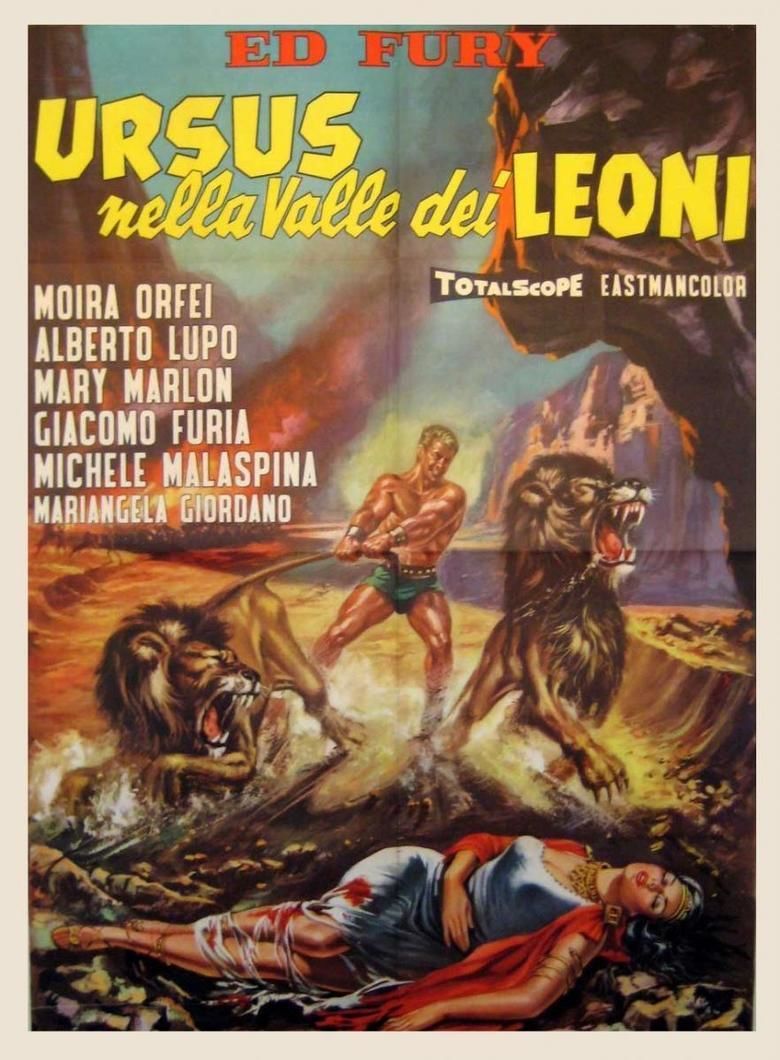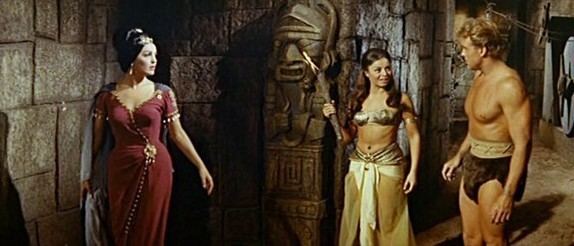Ursus in the Valley of the Lions
5.4 /10 1 Votes
Duration | 5.2/10 IMDb Genre Action, Adventure, Drama Running time 1h 34m Country Italy | |||||||||||||||||||||||||||||||||
 | ||||||||||||||||||||||||||||||||||
Release date December 21, 1961 (1961-12-21) Writer Giuseppe Mangione (story), Giuseppe Mangione (screenplay), Sandro Continenza (screenplay) Screenplay Sandro Continenza, Giuseppe Mangione Cast (Ursus), (Attea), (Ayak), (Simud), María Luisa Merlo , Michele Malaspina Similar movies Sheba and the Gladiator , The Last Gladiator , Hercules, Prisoner of Evil , The Last Days of Pompeii , Il ritorno del gladiatore più forte del mondo , In the shadow of the eagles | ||||||||||||||||||||||||||||||||||
Clip from ursus in the valley of the lions by film clips
Ursus in the Valley of the Lions (Italian: Ursus nella valle dei leoni, also known as Valley of the Lions) is a 1962 Italian peplum film directed by Carlo Ludovico Bragaglia. Although it was the fourth film in the Italian "Ursus" series, it was the first to provide Ursus with an origin story, explaining how he was raised by a lioness (very similar to "Tarzan of the Apes" in plot). Ed Fury once again played Ursus, and Alberto Lupo played the villanous Ajak.
Contents

When the film was distributed in the USA, the title was shortened to simply Valley of the Lions (Ursus' name was omitted from the title for some reason). This film was also distributed as Son of Atlas in the Valley of the Lions.
An interesting note is that the actors who played the two villains in this film both appeared in Italian cult horror films as well. Alberto Lupo (King Ajak) had played the monster in Atom Age Vampire (1960), while Gerard Herter (who played Ajak's henchman Lothar in the film) had played a maniacal killer in Caltiki, the Immortal Monster (1959).
Cast
Plot
The evil dictator Ajak sends his armies to attack a neighboring kingdom, and during the battle, the besieged King Annurius orders one of his subjects to take his son Ursus to a place of safety outside of the city, after first putting a royal medallion around the baby's neck. Ajak kills the king and usurps his throne, but the infant prince is smuggled out of the city to safety.
Later through a series of incidents, the baby Ursus winds up being abandoned alone in a hidden valley in the wilderness where he is adopted and raised by a pride of lions who mistake him for one of their cubs. In a storyline similar to "Tarzan of the Apes", Ursus grows to manhood with the lions as his family.
One day, a caravan of slave girls heading to market breaks down near Ursus' cave and after repairing their wagon, Ursus takes Ania, one of the slave girls, as his payment. A plot point that is never explained is that Ursus is somehow able to converse with people fluently, although he had spent his entire life interacting only with lions in a cave! (Why is he even clothed?)
The evil king Ajak is still alive and sitting on Ursus' father's throne at this point, and when Ajak hears that Ursus is still alive, he fears that Ursus will one day come seeking revenge and orders his soldiers to journey to the valley of the lions and arrest him. The soldiers kill all but one of the lions with poisoned meat, and when Ursus refuses to surrender, Ajak's men kidnap the slave girl Ania and use her as a hostage to force Ursus to give up. Simba, the last surviving lion of the pride, follows the chained Ursus to Ajak's city, trying to remain close to Ursus in the event that an opportunity to help him arises.
At the climax of the film, Ajak orders that a group of innocent townspeople be dragged into a raging pyre by a group of elephants to which they are chained. Ursus manages to free himself from the king's dungeon and kill Ajak's henchman Lothar by throwing him into a kennel of ferocious, slavering hyenas (!). Ursus then makes his way to the grand arena and physically holds back the elephants, saving the condemned civilians from a fiery death. When the people realize Ursus is their rightful ruler and revolt against their evil king, Ajak tries to sneak out of the arena, but he is attacked and mauled to death by Simba the lion, who spent the last half of the picture waiting patiently to avenge the deaths of his fellow lions. (How Simba knew that Ajak had ordered the killings is as much a mystery as how a man raised by lions can speak English, but it's still satisfying to see Ajak ripped apart.) At the end, the people declare Ursus their king, and with Ania as his queen, Ursus reclaims his father's throne.
Overview
The villains in this film weren't as interesting as in some of the other pepla of the time (Alberto Lupo as Ajak, and Gerard Herter as his henchman Lothar). The director definitely spiced up the elephant scene by decorating the elephants in imaginative circus raiments and having them pull the villagers toward the fire in a tightly choreographed, theatrical series of steps synchronized to resounding drumbeats.
The most frightening scene in the film involves the 4 ravenous, rabid-looking hyenas that attack Ursus in an underground tunnel; the creatures really do look rabid and appear to be seriously trying to kill Ed Fury; yet the actor is shown very physically grabbing the ghastly animals by their tails and actually swinging them around with his bare hands.
The lion sequences were obviously done with a trainer doubling for Ed Fury, and the mauling scene at the end looked more like the lion was trying to lick Ajak to death while he screams and writhes in agony, but then animal action scenes in these films are always difficult to execute. At least this film attempted to provide Ursus with an origin story, as preposterous as it was entertaining.
References
Ursus in the Valley of the Lions WikipediaUrsus in the Valley of the Lions IMDb Ursus in the Valley of the Lions themoviedb.org
